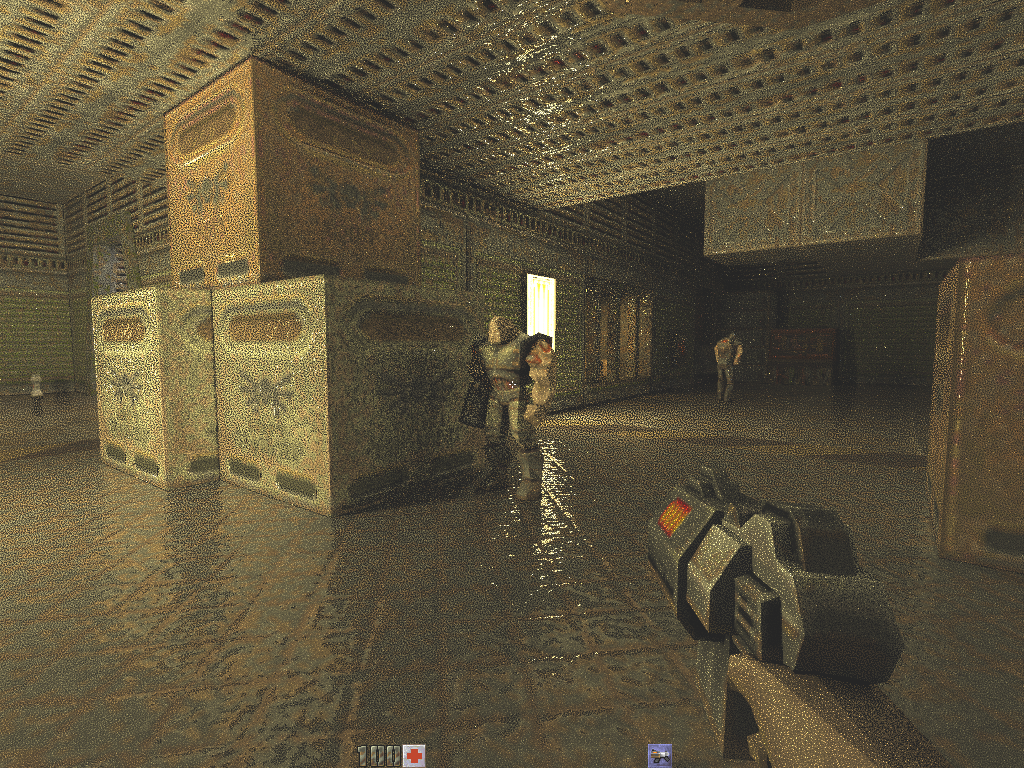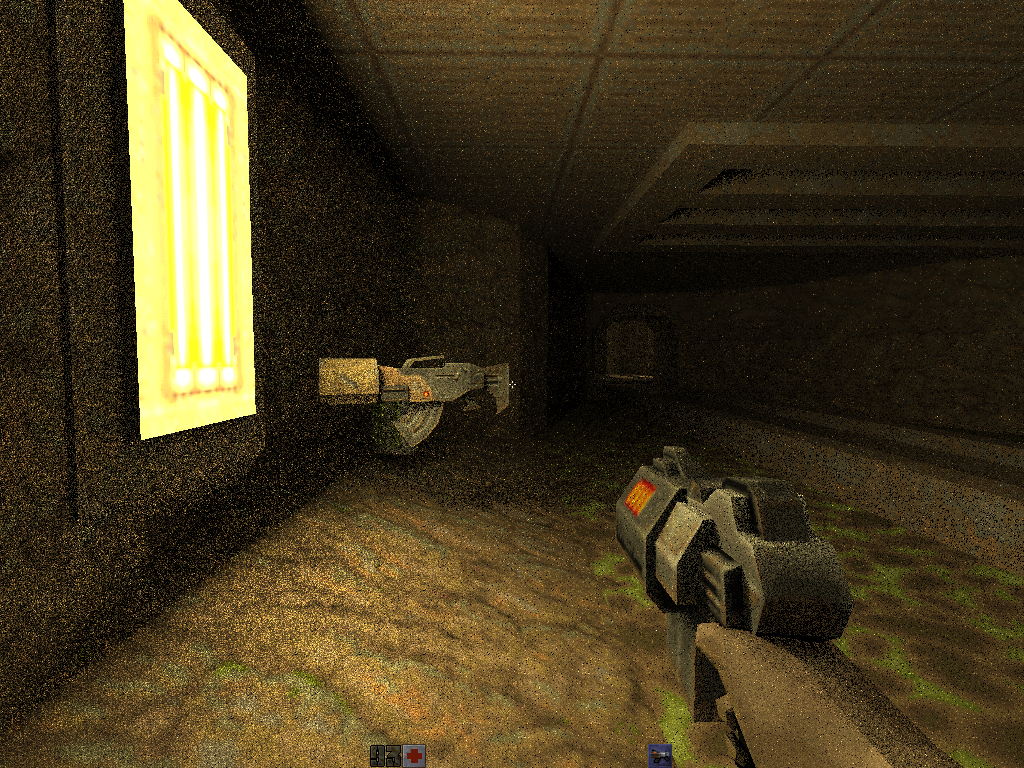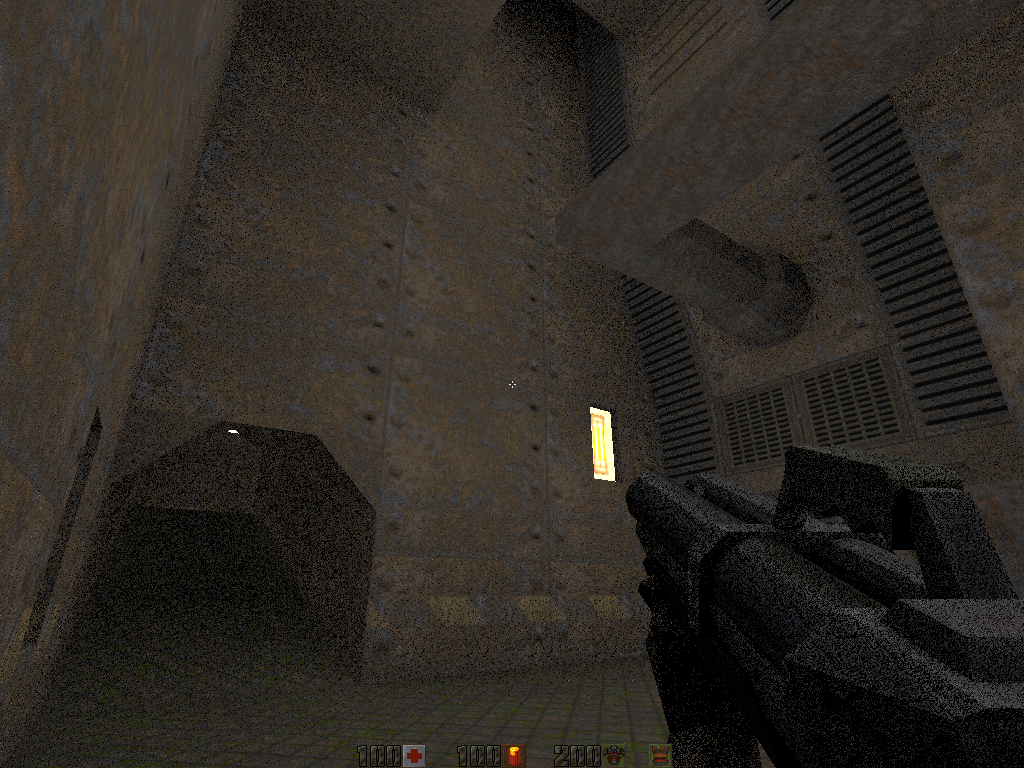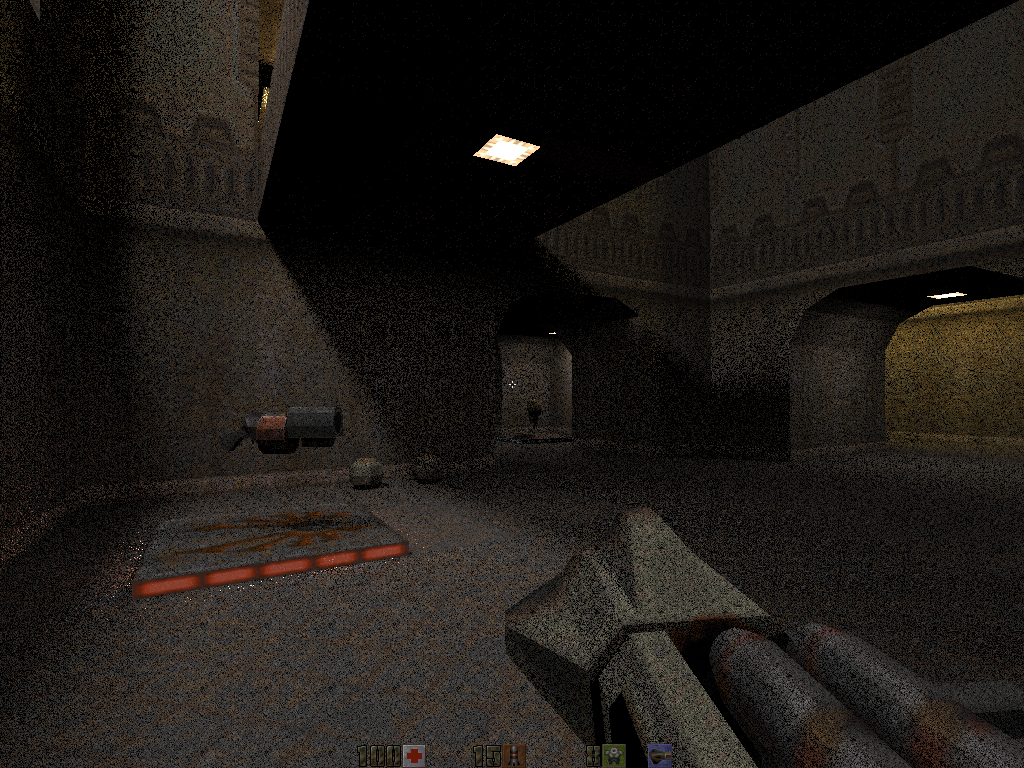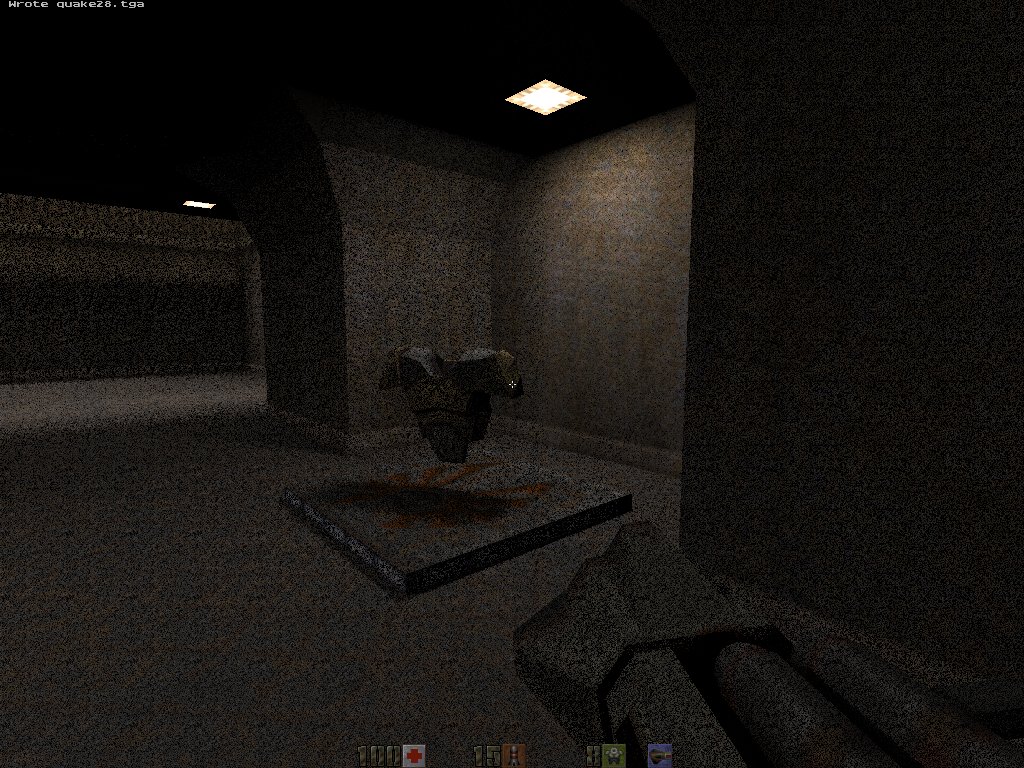Last Update: May 2020
Quake 2 Realtime GPU Pathtracing
This is a from-scratch GPU-based pathtracer created specifically for Quake 2. It has several optimisations which are only viable due to the typical characteristics of Quake 2 such as support for parallogram-shaped lightsources, BSP ray traversal, and special handling of sky 'surfaces' (portals). It doesn't officially have a name, but you can call it Raylgun.
- Supports all static and dynamic light types that were used in the original game, for which illumination was originally baked into static lightmaps.
- All objects can cast shadows.
- In terms of graphics API support, only OpenGL 3.3 is required.
- Requires no offline pre-processing of input data, so any mod or level which works with Yamagi Quake 2 (which is a no-frills port) should work.
- Still uses the rasterisation capabilities of the GPU anywhere that it makes sense.
- All code modifications reside within the refresher (Quake 2's rendering subsystem) and the pathtracing codepath can be averted entirely at runtime without qualitative detriment to the original renderer's results.
Sam Lapere (of Ray Tracey fame) made a great post putting together a lot of my answers to his questions about this project, and also provided some useful tips on getting it running yourself. Sam is quite passionate about raytracing in videogames, be sure to check out his other posts and past projects.
In 2019, a Vulkan-based renderer using NVIDIA RTX for hardware-accelerated raytracing was created for Quake 2 with a similar goal to this project. You can find out all about that project here. Judging by the About section of that page, my project which began in 2016 served as something of an inspiration for Q2VKPT.
Update Log
May 2020
- Fixed a random number sampling precision bug.
- Fixed a bug which prevented correct random number sampling on AMD GPUs.
- Fixed a couple of minor bugs.
- Improved sampling with blue noise dithering and Halton sequence sample points.
- Added TAA (temporal anti-aliasing) using raytracing to detect disocclusions, rather than colour history or G-buffer data.
- Added support for moving lightsources attached to level objects such as elevators.
- Added bump mapping, with bumpmaps generated on start-up from diffuse texture brightness.
- Added Simple Reinhard tonemapping with exposure control, and a gamma correction parameter.
- Added specular reflections of light sources and indirect lighting.
- The player's own weapon no longer casts shadows on the level geometry (it can still receive shadows, and it still casts shadows on itself).
- Fixed a significant slowdown caused by GL buffer usage flags, in relation to dynamic entity lights.
- Added more console variables.
- Fixed numerous minor bugs.
- Initial release.
Here are some average framerate measurements as measured by Quake 2 itself along with the graphics hardware that was used:
| AMD FirePro W8100 | 49.3 fps |
| NVIDIA Quadro K6000 | 32.8 fps |
| GeForce GTX 960 | 31.1 fps |
| AMD FirePro W7100 | 29.3 fps |
| GeForce GTX 680 | 22.1 fps |
Links
YouTube Video 4 (new for August 2017)
GitHub Page
Out-dated Links
YouTube Video 1 (old)
YouTube Video 2 (old)
YouTube Video 3 (old)
Console Commands
| gl_pt_recompile_shaders | Forces the shader programs to be recompiled. This is usually necessary after altering some aspect of the pathtracer via the console because some parameters are inserted into the shader source code itself. |
| gl_pt_print_static_info | Prints some pathtracing-related information about the current map. This information only pertains to things which are processed at map loading time. |
Console Variables
| Name | Purpose | Requires vid_restart | Requires gl_pt_recompile_shaders |
| gl_pt_enable | Enables the pathtracing codepath. When this is set to zero, the original Quake 2 rendering is used and all other pathtracer settings are ignored. | No | No |
| gl_pt_stats_enable | Enables a continuous display of per-frame information. This is useful for finding out how well the pathtracer is performing. | No | No |
| gl_pt_bounces | The number of secondary bounces of light. A value of 0 means all illumination is direct. Note: The sky is not sampled by secondary bounces. | No | Yes |
| gl_pt_shadow_samples | The number of shadow rays to cast towards an individual lightsource. A higher number of shadow samples means less noise in shadows. Zero shadow samples means no shadows at all. | No | Yes |
| gl_pt_light_samples | The number of light samples to make. A higher number of light samples means less noise overall, but the shader must re-compute importance sampling weights for each light sample (since storing them in registers is prohibitively slow). Zero light samples means no light from explicitly-sampled lightsources. | No | Yes |
| gl_pt_sky_enable | Enables light emission from the sky. If this is disabled then the sky itself is still drawn, it just won't emit any light. | No | Yes |
| gl_pt_sky_samples | The number of BRDF-sampled rays to trace and test against skyportals. | No | Yes |
| gl_pt_ao_enable | Enables ambient occlusion | No | Yes |
| gl_pt_ao_radius | The ambient occlusion radius. | No | No |
| gl_pt_ao_color | The color of the ambient occlusion contribution. Note: This is a scalar value because Quake 2's console doesn't allow vector-valued variables. | No | No |
| gl_pt_ao_samples | The number of BRDF-sampled rays to trace for ambient occlusion. | No | Yes |
| gl_pt_translucent_surfaces_enable | Currently not used, but will be used to enable the application of pathtracing to translucent surfaces. | No | No |
| gl_pt_lightstyles_enable | Enables the use of lightstyles (animated colour and intensity of static entity lightsources). | No | No |
| gl_pt_dlights_enable | Enables the use of dlights (dynamic lightsources created at runtime by entities). | No | No |
| gl_pt_brushmodel_shadows_enable | Enables the casting of shadows by brushmodels (entities with rigid polygonal geometry defined by the BSP). | No | Yes |
| gl_pt_aliasmodel_shadows_enable | Enables the casting of shadows by aliasmodels (entities with deforming triangle mesh geometry defined by separate MD2 files). | No | Yes |
| gl_pt_bounce_factor | The scalar amount of absorption simulated at each surface-light interaction in secondary bounces. Has no effect if the number of bounces is zero. | No | No |
| gl_pt_diffuse_map_enable | Enables the modulation of light by the surface albedo maps (the original textures of Quake 2). | No | Yes |
| gl_pt_static_entity_lights_enable | Enables the creation of static entity lights when the map is loaded. These lights can be quite costly as for each one 4 triangular lightsources are created, arranged in a tetrahedron. | Yes | No |
| gl_pt_depth_prepass_enable | Enables a depth pre-pass which draws all entities into the depth buffer before pathtracing is performed. This eliminates overdraw (except for translucent surfaces) with minimal drawcall overhead so is recommended for improving performance. | No | No |
| gl_pt_taa_enable | Enables temporal anti-aliasing, which is a form of anti-aliasing which re-uses the previously-rendered frame and blends between them in a smart way. | No | Yes |
| gl_pt_exposure | Sets the exposure parameter for tone-mapping. Currently the tonemapping is Simple Reinhard only. | No | No |
| gl_pt_gamma | Sets the gamma exponent of the display. Gamma is applied after tonemapping but before TAA, due to engine limitations. | No | No |
| gl_pt_bump_factor | Sets strength of the bumpmapping effect. A higher value means more pronounced bumps. | No | No |
| gl_pt_bump_enable | Enables the bumpmapping effect. Bump maps are generated automatically from diffuse maps by interpreting diffuse pixel brightness as bump height. | No | Yes |
| gl_pt_brushlights_enable | Enables the casting of light from brushlights, which are those lights attached to moving level objects such as elevators and platforms. | No | No |
| gl_pt_specular_factor | Sets a factor adjusting the blending between pure diffuse and pure specular reflection. | No | No |
